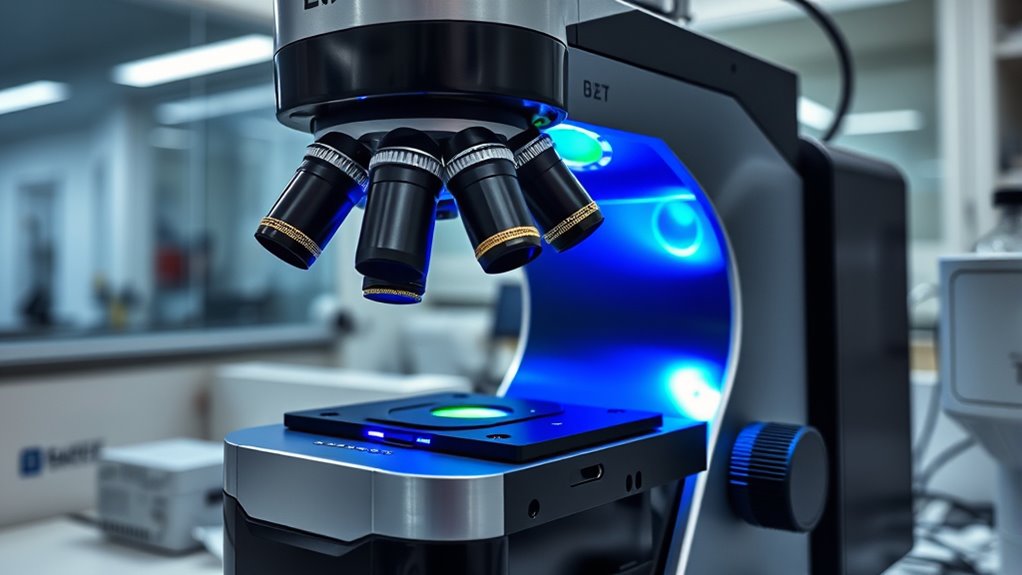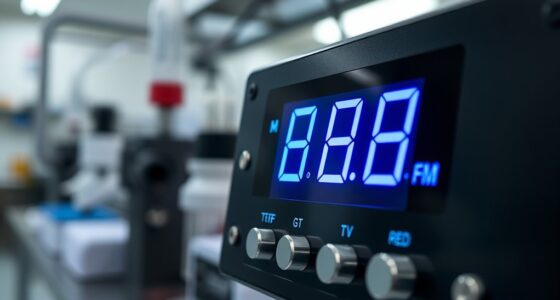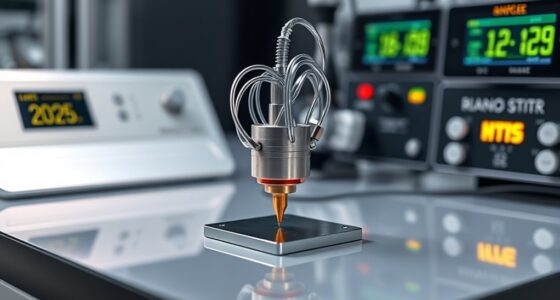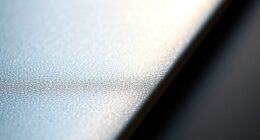If you’re looking for the best confocal microscopes in 2025, I recommend models that combine high resolution, versatile spectral capabilities, and user-friendly features. From research-grade systems with advanced optical sections to compact options for cellular analysis, there’s a wide range to choose from. These devices support fluorescence, multi-channel imaging, and real-time live view, making them ideal for complex biological research. Keep exploring to find out which microscope best fits your needs.
Key Takeaways
- Prioritize confocal microscopes with high-resolution objective lenses and sensitive detectors for detailed cellular imaging.
- Select models with multi-channel fluorescence capabilities and customizable spectral options for versatile research.
- Consider systems offering digital integration, remote control, and image analysis software for efficient workflow.
- Ensure compatibility with various sample types, sizes, and mounting methods for diverse experimental needs.
- Focus on ergonomic design and stability features to support prolonged, precise imaging sessions.
Compound Microscope with Dual LED Lighting and Mechanical Stage
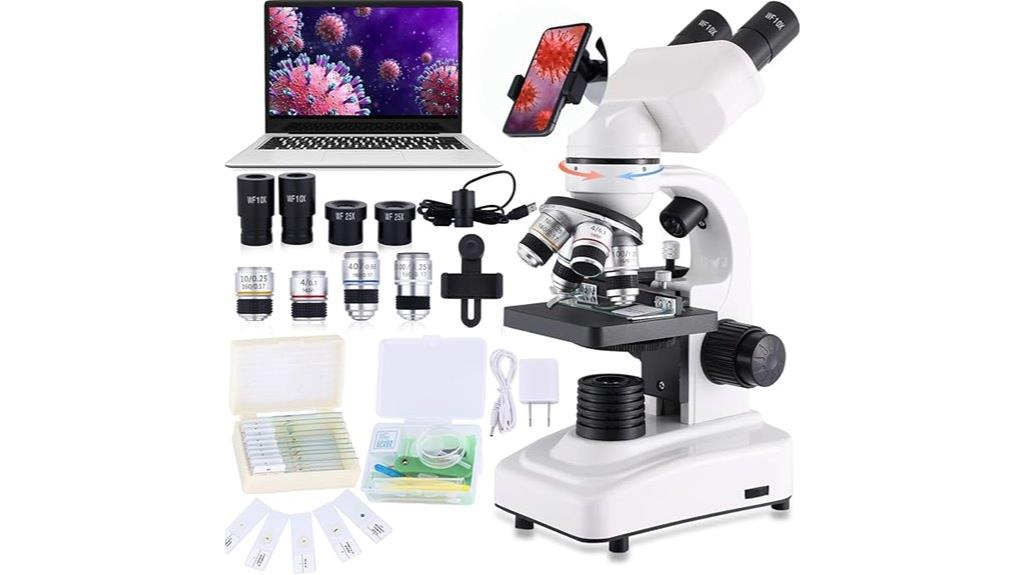
If you’re just starting out in bioscience or exploring microscopy as a hobby, the compound microscope with dual LED lighting and a mechanical stage offers an accessible entry point. It features an all-optical ultra-wide-angle binocular eyepiece, providing clear, sharp images with a large field of view to reduce eye fatigue. Its magnification ranges from 40X to 2500X, ideal for detailed cellular views. The dual LED lights—including top and bottom illumination—ensure bright, accurate coloring. The mechanical stage allows precise sample positioning, while its compact, lightweight design makes it portable. Although some limitations exist in image sharpness at high magnifications, it’s perfect for beginners exploring the fascinating world of microscopy.
Best For: beginners, students, and hobbyists interested in exploring basic bioscience and microscopy without professional-grade requirements.
Pros:
- All-optical ultra-wide-angle binocular eyepiece provides clear, sharp images with a large field of view, reducing eye fatigue.
- Wide magnification range from 40X to 2500X allows detailed observation of cellular structures.
- Compact, lightweight design offers portability and ease of use for beginners and casual users.
Cons:
- Image sharpness and clarity may decline at higher magnifications, with some users reporting focus issues.
- Build quality concerns, such as loose parts, dirty lenses, and inconsistent manufacturing, can affect durability and performance.
- Digital features like USB connectivity and software are often unreliable or incompatible, limiting digital imaging capabilities.
Compound Microscope with Dual LED Lighting and Mechanical Stage
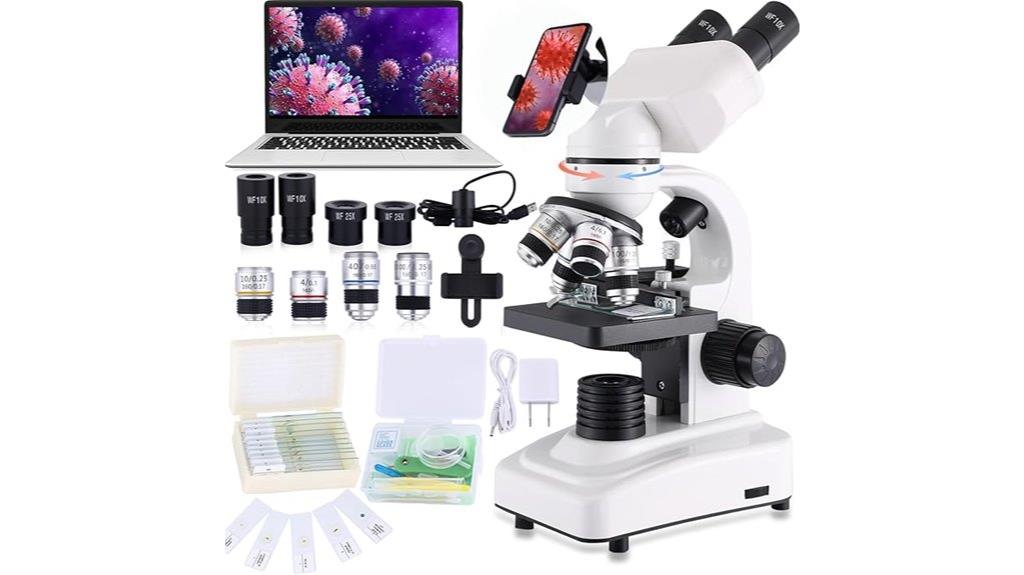
The compound microscope with dual LED lighting and a mechanical stage is an excellent choice for students, hobbyists, and educators seeking precise sample positioning combined with versatile illumination. Its all-optical, ultra-wide-angle binocular eyepiece offers clear, sharp images with a large field of view, reducing eye fatigue during long sessions. With magnification from 40X to 2500X, it allows detailed views of cellular structures. The dual LED lights, including top and bottom illumination, provide adjustable lighting for clearer images. The large mechanical stage with a spiral scale ensures precise sample adjustments, making this microscope suitable for educational use and casual exploration.
Best For: students, hobbyists, and educators seeking an affordable microscope with versatile illumination and sample positioning for basic educational and casual exploration.
Pros:
- All-optical ultra-wide-angle binocular eyepiece provides clear, sharp images with a large field of view.
- Adjustable dual LED lighting system enhances image clarity and allows for different illumination needs.
- Large mechanical stage with spiral scale facilitates precise sample positioning and adjustments.
Cons:
- Image quality and focus may be inconsistent at higher magnifications, limiting detailed scientific observation.
- Some users report issues with build quality, including loose parts and defective lenses.
- Digital imaging features via USB may lack compatibility, clear instructions, and reliable performance.
Trinocular Microscope with HD USB Camera and Mechanical Stage

Designed for researchers and educators seeking a versatile, high-quality microscope, the Trinocular Microscope with HD USB Camera and Mechanical Stage offers impressive magnification from 40X to 5000X. Its laboratory-grade construction includes wide-angle eyepieces, 2x lenses, and a high-pixel HD camera, making documentation straightforward. The infinity optical system with 195 achromatic objectives ensures sharp, color-accurate images by minimizing interference. The double-layer mechanical stage, adjustable focus, and ergonomic design support long observation sessions with reduced eye strain. With extensive accessories and user-friendly features, it’s an excellent choice for biological studies, teaching, and professional inspection.
Best For: educators, students, and hobbyists seeking a versatile, high-quality microscope for biological research, teaching, and inspection tasks.
Pros:
- Wide magnification range from 40X to 5000X for various detailed observations
- High-quality optical system with achromatic objectives for sharp, color-accurate images
- Comprehensive accessories included, perfect for experiments, teaching, and documentation
Cons:
- Assembly can be challenging due to unclear instructions and small parts
- Some users report debris on lenses and occasional mechanical sticking
- Limited professional-grade features, not suitable for advanced laboratory research
Microscope for Adults with HD USB Camera and Dual Mechanical Stages
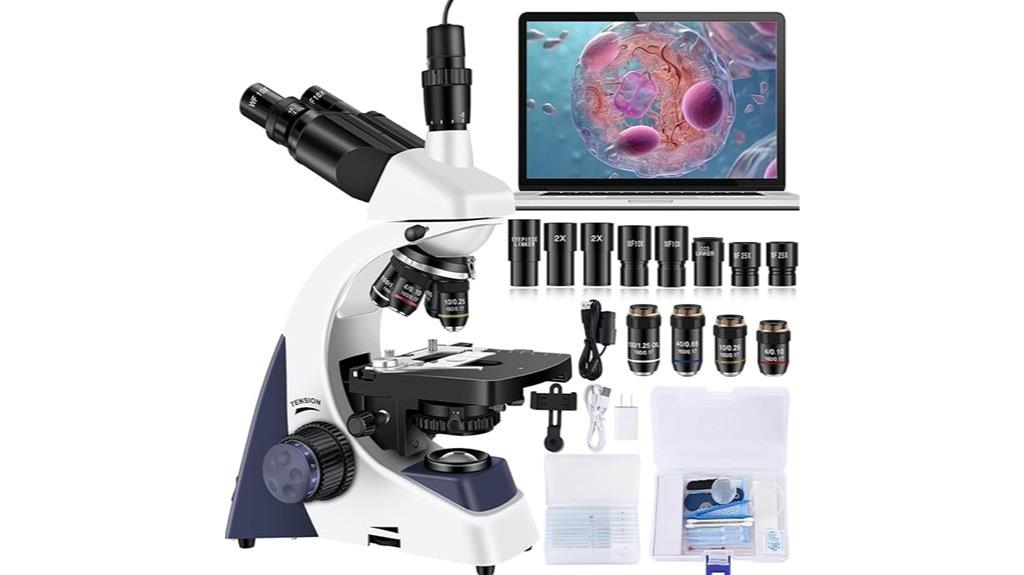
For researchers seeking precise and versatile observation, the Microscope for Adults with HD USB Camera and Dual Mechanical Stages stands out with its high magnification range of up to 5000X and lab-grade trinocular design. It supports biological research, education, pet hospital inspections, and animal testing. Features include dual mechanical stages for accurate specimen positioning, a wide-angle optical design, and adjustable pupil spacing for comfortable viewing. The HD USB camera allows seamless image capture through cell phone or computer, while high-quality achromatic lenses ensure sharp, clear images. Its durable construction, adjustable focusing, and extensive accessories make it a dependable choice for detailed, professional observation.
Best For: researchers, educators, and veterinary professionals needing high-precision, versatile microscopy for biological, educational, or animal testing applications.
Pros:
- Up to 5000X magnification with high-quality achromatic lenses for sharp and clear imaging.
- Dual mechanical stages for precise specimen positioning and easy adjustments.
- Supports image capture via HD USB camera compatible with cell phones and computers.
Cons:
- Relatively heavy at 11.4 pounds, which may affect portability.
- Requires familiarity with advanced microscopy features for optimal use.
- Higher price point compared to basic microscopes, potentially limiting accessibility for casual users.
Research Grade Binocular Compound Microscope 40X-2000X

If you’re seeking a versatile microscope capable of high-resolution imaging in both educational and research settings, the Research Grade Binocular Compound Microscope 40X-2000X stands out. It features three achromatic objectives (4X, 10X, 40X), reaching up to 2000X magnification for detailed observation. The dual LED lighting system, with adjustable brightness and a five-color filter bar, enhances image clarity and reduces eye fatigue. Its coaxial coarse and fine focus knobs enable quick, precise adjustments, making it perfect for students, beginners, and amateur scientists. This microscope supports a wide range of experiments and research, offering sharp, real microscopic details with reliable performance.
Best For: students, educators, amateur scientists, and enthusiasts seeking high-resolution, versatile microscopy for educational, research, and experimental purposes.
Pros:
- Offers up to 2000X magnification with clear, sharp images thanks to three achromatic objectives.
- Features dual LED lighting with adjustable brightness and a five-color filter bar for customizable observation and reduced eye fatigue.
- Equipped with coaxial coarse and fine focus knobs for quick, precise adjustments, ensuring detailed imaging.
Cons:
- May be heavier and less portable due to its solid, professional build.
- Requires some familiarity with microscopy to maximize its complex features and adjustments.
- The cost may be higher compared to entry-level microscopes, reflecting its research-grade capabilities.
Microscope for Adults with HD USB Camera (WF10x/WF25x Eyepieces, 40X-2500X)
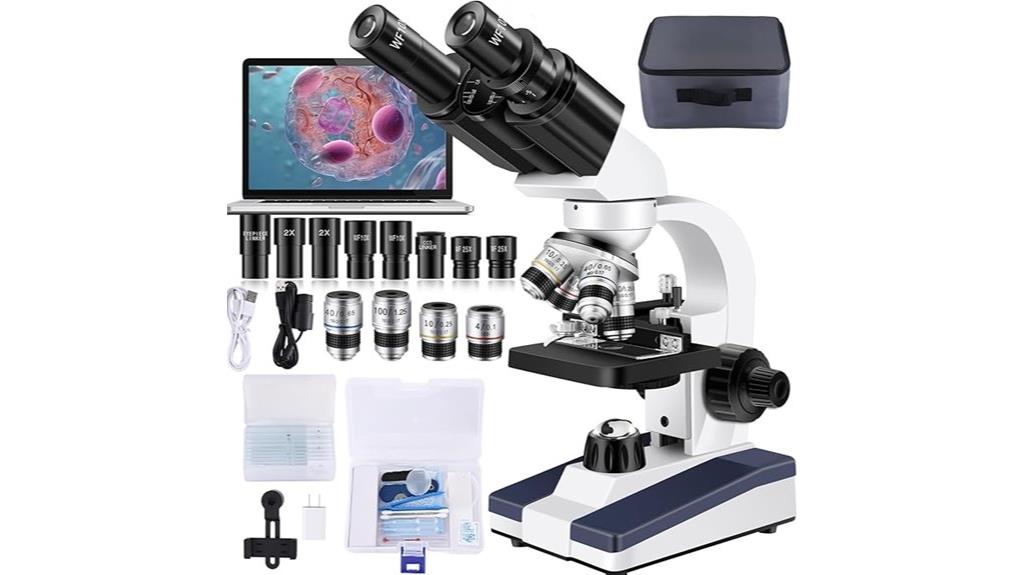
The Microscope for Adults with HD USB Camera (WF10x/WF25x Eyepieces, 40X-2500X) stands out as an excellent choice for hobbyists and educators seeking a versatile, user-friendly device. Its compound binocular design offers wide-angle eyepieces, high-quality achromatic objectives, and a rotating head for flexible observation. With magnification from 40X to 5000X, it captures detailed images through an HD USB camera compatible with smartphones and computers. Built with durable metal components and dual LED lighting, it’s suitable for biological testing, education, and DIY projects. Despite some manual inaccuracies, it provides excellent value for exploring cellular structures and specimens at various levels of detail.
Best For: hobbyists, educators, and curious adults seeking a versatile, easy-to-use microscope for biological exploration and DIY projects.
Pros:
- Sturdy metal construction with dual LED lighting for clear, detailed viewing.
- Wide magnification range from 40X to 5000X, suitable for various specimens.
- Compatible HD USB camera allows capturing high-quality images and videos easily.
Cons:
- Manual contains inaccuracies, especially regarding stage movement and accessory use.
- Smartphone adapter is cumbersome and may require modifications for better fit.
- Lacks a mechanical stage, limiting precise slide positioning during observations.
Compound Microscope for Kids & Students, 40X-2000X Magnification

A compound microscope with 40X-2000X magnification is an excellent choice for kids and students enthusiastic to explore the microscopic world. Its high-quality optics deliver sharp, clear images, while anti-glare and anti-distortion features reduce eye strain. The binocular design makes it easy for beginners to use comfortably. Compact and sturdy, it includes a complete slide set, batteries, and a storage case, making setup simple. With adjustable focus and versatile lenses, it supports detailed observation of cells, insects, and biological samples. Overall, it’s a durable, educational tool that sparks curiosity and enhances hands-on learning for young scientists.
Best For: Kids, students, and beginner scientists interested in exploring cells, insects, and biological samples through detailed microscopy.
Pros:
- High magnification range (40X-2000X) for versatile viewing of various specimens
- Easy-to-use binocular design suitable for beginners and children
- Comes with educational accessories like slides, specimens, and a sturdy storage case
Cons:
- Some users experience flickering lights and occasional focus difficulties
- Objective switch may stick, requiring careful handling
- Images at 40X may sometimes appear blurry, especially for new users
Compound Trinocular Microscope with USB Camera and Mechanical Stage

For researchers seeking a reliable, budget-friendly microscope with advanced features, the Compound Trinocular Microscope with USB Camera and Mechanical Stage stands out. It offers 40X-5000X magnification with four achromatic objectives for sharp, clear images. The LED illumination and adjustable diaphragm optimize lighting, while the double-layer mechanical stage ensures stable X-Y movement for precise specimen positioning. The 1.3MP USB camera supports live streaming, recording, and image capture, compatible with Mac and Windows. Constructed with quality materials, it’s portable yet sturdy. This microscope is perfect for research, education, and professional use, delivering detailed observations at an accessible price point.
Best For: researchers, educators, and professionals seeking an affordable yet advanced compound microscope for detailed microscopic observations and imaging.
Pros:
- Offers a wide magnification range (40X-5000X) with high-quality achromatic objectives for sharp images
- Equipped with a stable mechanical stage and adjustable LED lighting for precise and clear observations
- Includes a USB camera compatible with Mac and Windows for live streaming, recording, and capturing images
Cons:
- Some users may experience difficulty with software installation and camera setup
- Accessories like phone adapters and oil lenses may require adjustments or replacements for optimal use
- Customer feedback indicates occasional challenges with focusing adjustments and stage movement control
Compound Trinocular Microscope with 40X-5000X Magnification
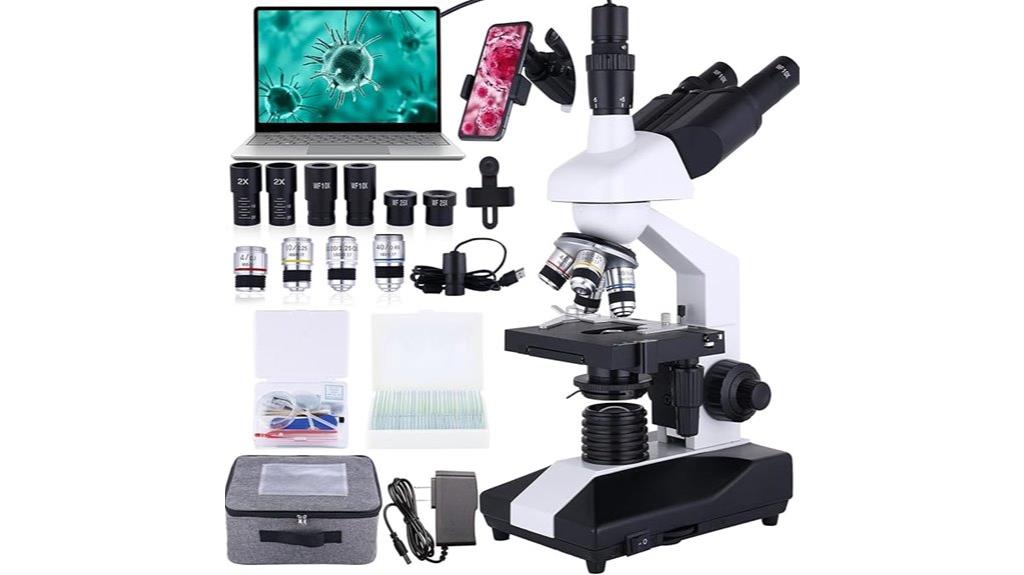
When selecting a microscope for detailed research, the Compound Trinocular Microscope with 40X-5000X magnification stands out thanks to its versatile optical system and high-quality objectives. It features 195 flat-field achromatic lenses, offering magnifications from 40X up to 5000X, ensuring sharp, clear images with accurate color. The binocular viewing system is adjustable for comfort, while the triocular head allows easy attachment of cameras for imaging. Its double-layer mechanical stage provides smooth specimen movement, and the Ambe condenser adjusts light intensity for various samples. Designed for precision, this microscope is perfect for research, education, and professional applications.
Best For: researchers, educators, and professionals requiring detailed, high-magnification microscopy for scientific, educational, or research purposes.
Pros:
- Wide magnification range from 40X to 5000X allows for versatile observation of various specimens.
- High-quality 195 flat-field achromatic lenses provide sharp, color-accurate images.
- Adjustable binocular and triocular heads with precise focus and smooth mechanical stage enhance ease of use and comfort.
Cons:
- The camera accessory is not included, requiring additional purchase for imaging capabilities.
- May be heavier and bulkier due to its advanced features, making portability limited.
- Slightly higher cost compared to basic microscopes, which could be a consideration for budget-conscious users.
Wireless Digital Microscope with WiFi, 50X-1000X Magnification, Portable Handheld HD Camera Compatible with iPhone, Android, iPad, Windows, Mac
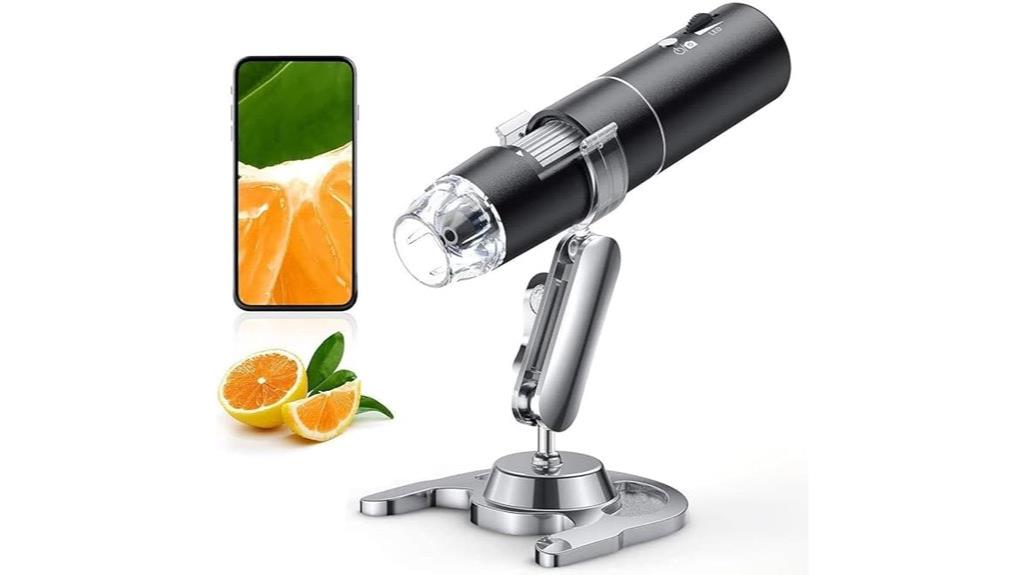
If you’re looking for a portable, easy-to-use microscope that offers high-quality imaging without the need for specialized equipment, the Wireless Digital Microscope Skybasic stands out. It features 50X-1000X magnification, a lightweight design, and compatibility with iPhone, Android, iPad, Windows, and Mac via WiFi or USB. The device has 8 adjustable LED lights, captures HD images and videos, and supports digital zoom up to 40X. Ideal for casual exploration, education, and hobbies, it’s simple to operate and highly portable. While not suited for professional research, its ease of use and versatility make it perfect for students and hobbyists alike.
Best For: casual users, students, and hobbyists seeking an affordable, portable digital microscope for educational and exploratory purposes.
Pros:
- Easy setup and operation with wireless and USB connectivity options
- Compact, lightweight design ideal for on-the-go use
- Good image quality with HD resolution and adjustable LED lighting
Cons:
- Digital zoom is limited to approximately 40X, with optical zoom around 20X, not the claimed 1000X
- Stand may be unstable; handheld use recommended for stability
- Focus is fixed and requires manual adjustment; no auto-focus feature
Grampus Achromatic Compound Microscope with Accessories
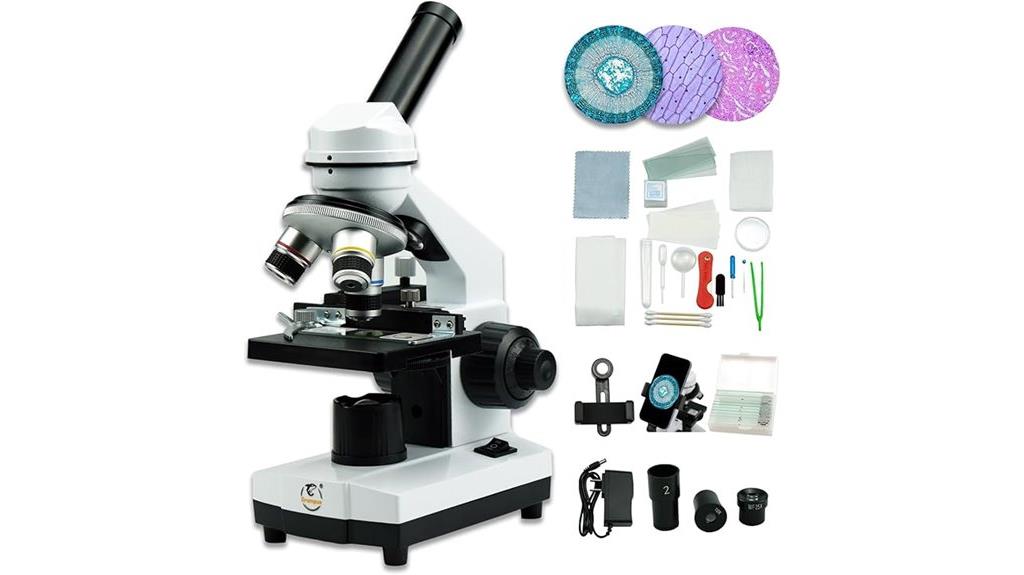
The Grampus Achromatic Compound Microscope with Accessories stands out as an excellent choice for educators and students seeking a versatile and portable microscopy solution. It offers magnification from 40X to 2000X with 10 adjustable settings, using 10X WF25X eyepieces and various objective lenses. The dual LED illumination system allows observation of both opaque and transparent samples. Its precise coaxial focus and mechanical stage ensure accurate positioning. Complete with slides, cover slips, and a sturdy, shockproof case, it’s perfect for classroom, DIY, or field use. This durable, battery-powered microscope makes hands-on learning accessible anywhere, fostering curiosity and scientific exploration.
Best For: educators, students, and hobbyists seeking a portable, versatile microscope for educational and DIY exploration.
Pros:
- Wide magnification range from 40X to 2000X for detailed observation of various specimens
- Dual LED lighting system allows clear viewing of both opaque and transparent samples
- Complete set of accessories, including slides and a sturdy, portable case, enhances usability and convenience
Cons:
- May be less suitable for high-end professional research requiring advanced features
- Requires batteries, which may need frequent replacement for extended use
- Slightly heavier than handheld microscopes, potentially affecting portability during extended outdoor use
SWIFT SW350B Binocular Microscope with 40X-2500X Magnification
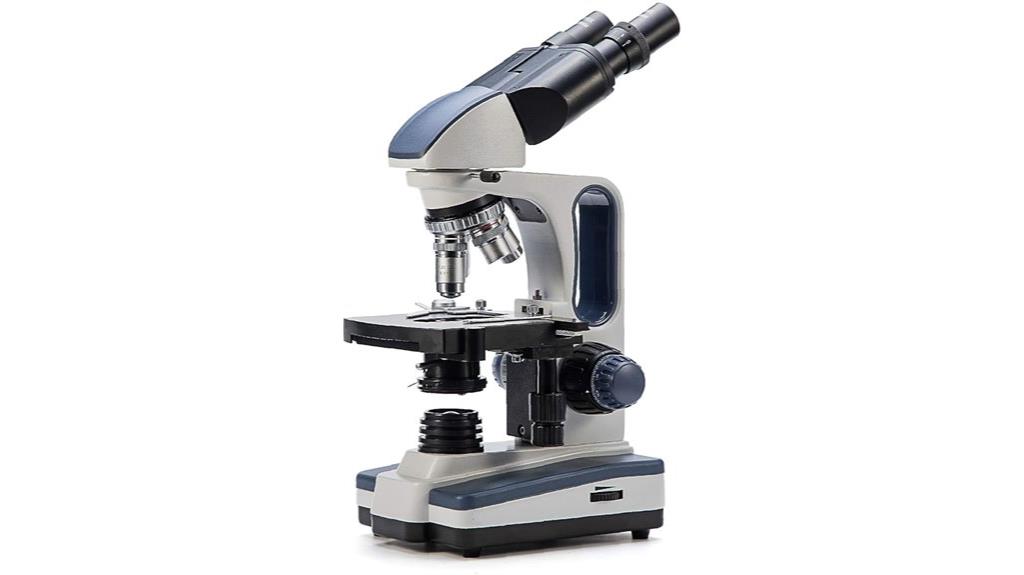
The SWIFT SW350B Binocular Microscope offers flexible magnification ranges from 40X to 2500X, making it an excellent choice for students, hobbyists, and educators seeking high-quality, versatile imaging. Its Siedentopf fully rotatable binocular head with adjustable interpupillary distance guarantees ergonomic viewing, while the four DIN Achromatic objectives provide six magnification levels. Bright LED illumination, a large mechanical stage, and polarizing disks enhance image clarity and detail. Built for durability, it features sturdy construction and user-friendly controls, making it ideal for educational and basic laboratory use. Despite minor focus and aperture limitations, it delivers excellent value and reliable performance.
Best For: students, hobbyists, and educators seeking a versatile, high-quality microscope for educational and basic laboratory use.
Pros:
- Offers a wide magnification range up to 2500X for detailed specimen analysis
- Ergonomic design with adjustable interpupillary distance and rotatable binocular head
- Durable construction with user-friendly controls and included accessories like polarizing disks and camera compatibility
Cons:
- Limited focus and aperture adjustment capabilities, which may affect image clarity at times
- Some users report minor issues with camera connection and loose screws
- Not suitable for professional research requiring ultra-precise focus or advanced imaging
Binocular Compound Microscope for Adults with Digital Eyepiece
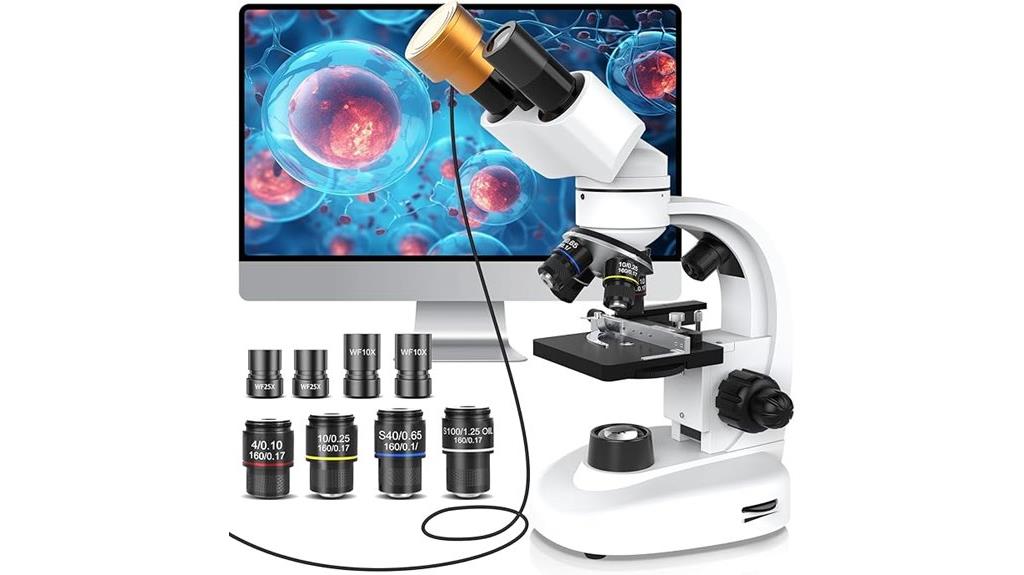
A binocular compound microscope with a digital eyepiece is an excellent choice for researchers and educators seeking versatile, high-magnification observation tools. I find the Wozel model particularly impressive, offering magnification from 40X to 2500X and smooth adjustment options. Its 360-degree rotatable binocular head with adjustable angles reduces neck strain, making prolonged use comfortable. Dual LED illumination and a mechanical stage provide stability and clarity for diverse samples. The included digital camera allows real-time imaging and recording, perfect for presentations or detailed analysis. While some users note minor issues at high magnification, overall, it’s a reliable, multi-purpose instrument suitable for both educational and research settings.
Best For: educators, students, and researchers seeking a versatile, high-magnification microscope with digital imaging capabilities for educational demonstrations and detailed biological analysis.
Pros:
- Wide magnification range from 40X to 2500X with seamless adjustment for detailed observation
- Ergonomic design with a rotatable, adjustable binocular head reducing neck strain during prolonged use
- Comes with high-resolution digital camera and accessories for real-time imaging, recording, and versatile applications
Cons:
- Some users report blurry images at higher magnifications, affecting detailed observation
- Design may be uncomfortable for extended use, with potential issues like eyelash contact and lens smudging
- Optics at lower magnifications can sometimes be unclear, requiring careful adjustment for optimal viewing
AmScope SE306R-PZ Binocular Stereo Microscope

If you’re seeking an affordable yet versatile stereo microscope, the AmScope SE306R-PZ stands out with its three magnification settings—20X, 40X, and 80X—that cover a broad range of detailed observations. It features high-quality widefield optical glass lenses for sharp, clear images and a 10X-80X zoom for fine adjustments. The 45-degree inclined binocular head ensures comfortable viewing, while rubber eye-guards add extra comfort. Its sturdy all-metal pillar stand provides stability. Equipped with built-in halogen lights—incident and transmitted—it’s perfect for examining surfaces, microelectronic components, jewelry, and biological specimens. This model is a practical choice for hobbyists, students, and professionals alike.
Best For: hobbyists, students, and professionals seeking an affordable, versatile stereo microscope for detailed surface and material examination.
Pros:
- High-quality widefield optical glass lenses deliver sharp, clear images with high resolution.
- Multiple magnification options (20X, 40X, 80X) with 10X-80X zoom for precise adjustments.
- Built-in incident and transmitted halogen lights provide versatile illumination for various applications.
Cons:
- Weight of approximately 1 pound may impact stability if not mounted securely.
- Limited to three fixed magnification settings, which may not suit all detailed viewing needs.
- The all-metal stand, while sturdy, may add to the overall size and weight of the setup.
Factors to Consider When Choosing Confocal Microscopes for Research
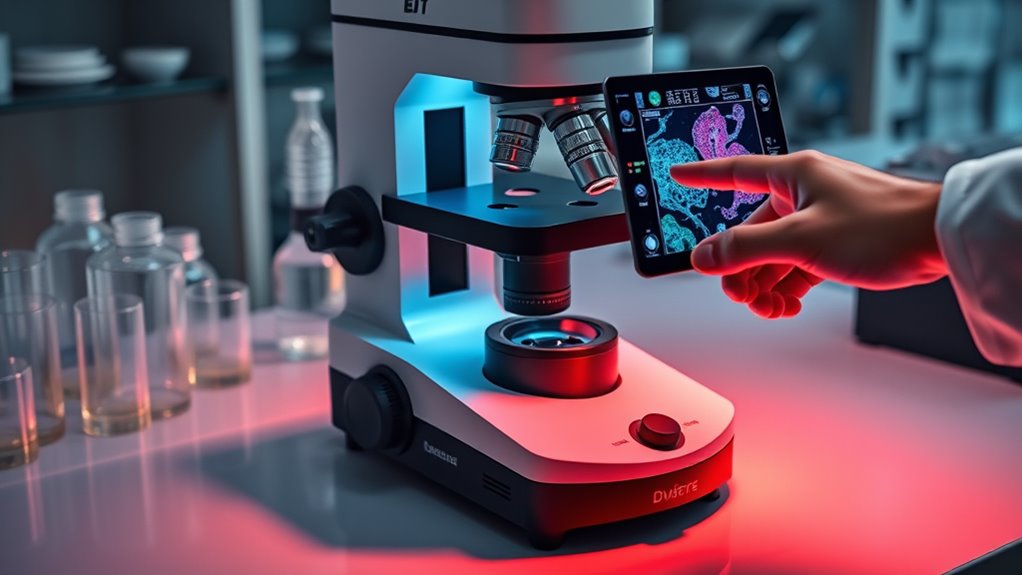
When selecting a confocal microscope, I focus on several key factors to guarantee it meets my research needs. Imaging resolution, sample compatibility, and optical system features directly impact the quality and versatility of my work. Additionally, I consider ease of operation and digital integration options to streamline workflows and data management.
Imaging Resolution Quality
Choosing a confocal microscope with high imaging resolution hinges on understanding several key factors. The objective lens’s numerical aperture (NA) is vital—higher NA values deliver sharper, more detailed images. The emitted light’s wavelength also matters; shorter wavelengths like blue or ultraviolet can resolve finer structures than longer wavelengths. Additionally, the pinhole aperture size impacts resolution by filtering out out-of-focus light, enhancing clarity. Advances in detector sensitivity and pixel density allow for capturing more precise details. Keep in mind, though, that the maximum resolution is limited by the diffraction limit, approximately 200 nanometers laterally. Balancing these factors ensures you select a confocal system capable of delivering the high-resolution images necessary for your research’s accuracy and depth.
Compatibility With Samples
Selecting a confocal microscope that matches your samples’ physical and chemical properties is vital for effective imaging. You need to take into account the size, shape, and transparency of your samples to guarantee proper handling and focus. Compatibility with fluorescence markers or dyes is also critical; verify that the microscope supports their excitation and emission wavelengths for clear signal detection. Additionally, confirm that the system accommodates your sample mounting methods, whether slides, coverslips, or specialized holders for thicker specimens. It’s important that the system can handle your sample’s biological or material composition without causing damage or distortion. Finally, ensure the laser lines and detection capabilities match your spectral requirements to achieve ideal contrast and resolution, maximizing your imaging results.
Optical System Features
The optical system lies at the heart of a confocal microscope’s imaging capabilities, directly influencing image quality and resolution. It uses point illumination and spatial pinholes to eliminate out-of-focus light, producing sharp, high-resolution images. Laser or LED light sources provide precise, monochromatic illumination, vital for fluorescence and multi-channel imaging. High numerical aperture objectives with specialized coatings enhance contrast and detail. Adjustable pinhole sizes allow me to balance optical section thickness and signal intensity, optimizing clarity. Advanced systems often include multiple detectors or spectral separation components, enabling detailed multi-color or multi-modal imaging. These features ensure I can customize the setup for different samples and research needs, maximizing both resolution and image clarity, which are fundamental for accurate scientific analysis.
Ease of Operation
When evaluating confocal microscopes for research, ease of operation is a vital factor that can substantially impact your workflow. An intuitive interface with simple controls helps reduce the learning curve, allowing you to start imaging quickly. Automated features like autofocus and preset protocols minimize manual adjustments, speeding up data acquisition and reducing user fatigue. User-friendly software with clear navigation and troubleshooting support makes it easier for both beginners and experienced users to operate the system efficiently. Ergonomic design elements, including accessible control panels and comfortable sample handling, enable prolonged use without discomfort. Additionally, thorough training resources and detailed manuals ensure you can quickly master complex functions and optimize imaging procedures, making ease of operation essential for productive research.
Digital Integration Options
Digital integration options are essential to maximizing the functionality and efficiency of confocal microscopes. Modern models often include integrated digital cameras that capture high-resolution images and stream live to computers or tablets, streamlining data collection. Compatibility with software like ImageJ, Zen, or proprietary programs allows seamless processing, analysis, and storage of imaging data. Wireless features such as Wi-Fi or Bluetooth enable remote operation and real-time sharing across devices, enhancing flexibility. Some microscopes support 4K or higher video output, providing detailed visualization for complex samples. Additionally, digital tools like automated image stitching and 3D reconstruction improve research efficiency by enabling thorough analysis of large or multi-layered specimens. These features make digital integration a key factor in selecting the ideal confocal microscope for advanced research.
Frequently Asked Questions
What Are the Main Differences Between Confocal and Traditional Microscopes?
Confocal microscopes differ from traditional ones mainly through their ability to produce sharper, more detailed images. They use laser light to scan specimens point-by-point and eliminate out-of-focus light, giving you clearer, high-resolution 3D images. Traditional microscopes, on the other hand, rely on broad illumination and often produce flatter, less precise images. This makes confocal microscopes ideal for detailed biological research and cellular imaging.
How Does Laser Intensity Affect Image Quality in Confocal Microscopy?
Think of laser intensity like the fuel in a fire; too much or too little can dim or scorch your image. Higher laser intensity boosts signal strength, revealing finer details, but risks photobleaching and damaging samples. Lower intensity preserves samples but may produce grainy images. Striking the right balance guarantees sharp, clear images without compromising sample integrity — a delicate dance I always aim to master.
What Maintenance Is Required for Optimal Confocal Microscope Performance?
To keep my confocal microscope performing at its best, I regularly clean lenses and check for dust or debris. I calibrate the system periodically to guarantee accuracy, and I update the software to benefit from improvements. I also monitor laser alignment and replace any worn-out parts promptly. Routine maintenance like these helps me achieve consistent, high-quality imaging and extends the lifespan of my equipment.
Can Confocal Microscopes Be Used for Live-Cell Imaging?
You bet, confocal microscopes are perfect for live-cell imaging. I’ve used them to observe dynamic processes in real time, and they really shine with their high resolution and minimal photodamage. As long as you optimize the settings, like laser power and environmental controls, you can get clear, detailed images without harming your cells. It’s a game-changer for studying live biology, letting you see what’s happening right now.
What Safety Precautions Are Necessary When Operating Confocal Microscopes?
When operating confocal microscopes, I always wear appropriate eye protection and avoid direct exposure to laser beams to prevent eye damage. I guarantee proper ventilation and handle laser components with care, following manufacturer guidelines. I also keep the area clear of unnecessary personnel and never bypass safety interlocks. Regular training and maintenance are vital to stay safe and prevent accidents while achieving precise, high-quality imaging.
Conclusion
So, after reviewing these top picks, it’s clear that choosing the perfect confocal microscope isn’t exactly rocket science—unless, of course, you’re aiming for intergalactic clarity. With all these advanced options, I’d say your biggest challenge is resisting the urge to buy them all. But hey, who needs a spaceship when you can explore the universe right under your lens? Happy hunting—your research will thank you, even if your wallet protests.
